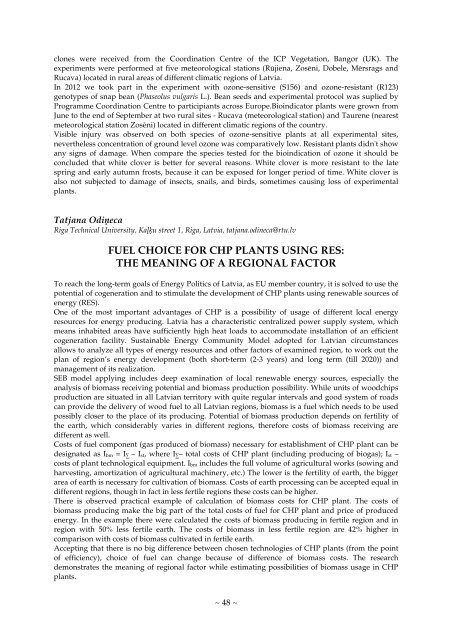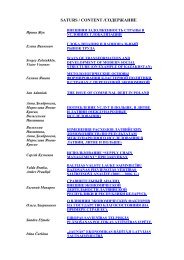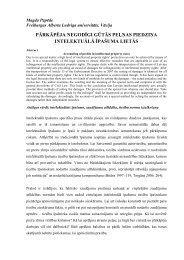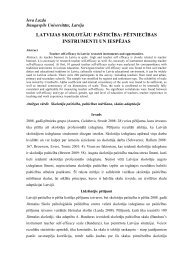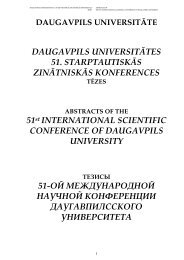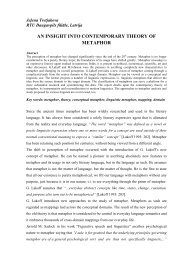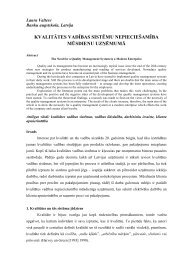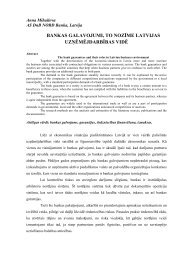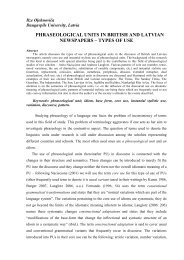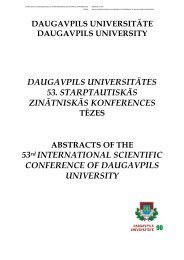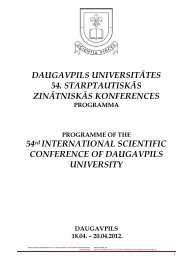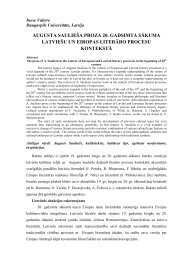clones were received from the Coordination Centre of the ICP Vegetation, Bangor (UK). Theexperiments were performed at five meteorological stations (Rūjiena, Zosēni, Dobele, Mērsrags andRucava) located in rural areas of different climatic regions of Latvia.In 2012 we took part in the experiment with ozone-sensitive (S156) and ozone-resistant (R123)genotypes of snap bean (Phaseolus vulgaris L.). Bean seeds and experimental protocol was suplied byProgramme Coordination Centre to participiants across Europe.Bioindicator plants were grown fromJune to the end of September at two rural sites - Rucava (meteorological station) and Taurene (nearestmeteorological station Zosēni) located in different climatic regions of the country.Visible injury was observed on both species of ozone-sensitive plants at all experimental sites,nevertheless concentration of ground level ozone was comparatively low. Resistant plants didn't showany signs of damage. When compare the species tested for the bioindication of ozone it should beconcluded that white clover is better for several reasons. White clover is more resistant to the latespring and early autumn frosts, because it can be exposed for longer period of time. White clover isalso not subjected to damage of insects, snails, and birds, sometimes causing loss of experimentalplants.Tatjana OdiĦecaRiga Technical University, KaĜėu street 1, Riga, Latvia, tatjana.odineca@rtu.lvFUEL CHOICE FOR CHP PLANTS USING RES:THE MEANING OF A REGIONAL FACTORTo reach the long-term goals of Energy Politics of Latvia, as EU member country, it is solved to use thepotential of cogeneration and to stimulate the development of CHP plants using renewable sources ofenergy (RES).One of the most important advantages of CHP is a possibility of usage of different local energyresources for energy producing. Latvia has a characteristic centralized power supply system, whichmeans inhabited areas have sufficiently high heat loads to accommodate installation of an efficientcogeneration facility. Sustainable Energy Community Model adopted for Latvian circumstancesallows to analyze all types of energy resources and other factors of examined region, to work out theplan of region’s energy development (both short-term (2-3 years) and long term (till 2020)) andmanagement of its realization.SEB model applying includes deep examination of local renewable energy sources, especially theanalysis of biomass receiving potential and biomass production possibility. While units of woodchipsproduction are situated in all Latvian territory with quite regular intervals and good system of roadscan provide the delivery of wood fuel to all Latvian regions, biomass is a fuel which needs to be usedpossibly closer to the place of its producing. Potential of biomass production depends on fertility ofthe earth, which considerably varies in different regions, therefore costs of biomass receiving aredifferent as well.Costs of fuel component (gas produced of biomass) necessary for establishment of CHP plant can bedesignated as I bm = I ∑ – I st, where I ∑– total costs of CHP plant (including producing of biogas); I st –costs of plant technological equipment. I bm includes the full volume of agricultural works (sowing andharvesting, amortization of agricultural machinery, etc.) The lower is the fertility of earth, the biggerarea of earth is necessary for cultivation of biomass. Costs of earth processing can be accepted equal indifferent regions, though in fact in less fertile regions these costs can be higher.There is observed practical example of calculation of biomass costs for CHP plant. The costs ofbiomass producing make the big part of the total costs of fuel for CHP plant and price of producedenergy. In the example there were calculated the costs of biomass producing in fertile region and inregion with 50% less fertile earth. The costs of biomass in less fertile region are 42% higher incomparison with costs of biomass cultivated in fertile earth.Accepting that there is no big difference between chosen technologies of CHP plants (from the pointof efficiency), choice of fuel can change because of difference of biomass costs. The researchdemonstrates the meaning of regional factor while estimating possibilities of biomass usage in CHPplants.~ 48 ~
Vladislavs Sardiko<strong>Daugavpils</strong> Universitāte, Parādes iela 1, <strong>Daugavpils</strong>, Latvija, v.sardiko@inbox.lvIETEIKUMI DAUGAVPILS PILSĒTAS GAISA KVALITĀTESMONITORINGAM, IZMANTOJOT PARASTAS PRIEDES (PINUSSYLVESTRIS) SKUJU MORFOMETRISKO RAKSTUROJUMUPēdējos gados, līdz ar straujo rūpniecības attīstību visā pasaulē pastiprinās gaisa piesārĦojums, kaskĜūst par aizvien nopietnāku vides problēmu. Tas ne vien nodara lielu kaitējumu dabai, bet būtiskiietekmē arī katra cilvēka veselību. Līdz ar to ir nepieciešams sekot gaisa piesārĦojuma līmenim. Šāmērėa īstenošanai iederas bioindikācijas metode, kaut bioindikācija nepārada konkrēto piesārĦojumalīmeni un neuzrada konkrētus skaitĜus, tomēr bioindikācijas metodes spēj paradīt gaisa piesārĦojumalīmeĦa svārstības salīdzinājumā, balstoties uz agrāk iegūtiem datiem, izmantojot tās pašasbioindikācijas metodes. Viens no bieži izmantotiem bioindikatoriem ir Parasta priede (Pinus sylvestris).Pietam, <strong>Daugavpils</strong> pilsētas mežos un piepilsētas mēžu teritorijās dominē tieši parastā priede. Irpieejamas daudzas metodes, bet tika izvelēta metode, kur tiek izmantots Parastas priedes (Pinussylvestris) skuju morfometriskie parametri. Jo, šīs metodes izmantošana ir lēta un viegla.Ilze Dovgiallo, Rasma Timša, Ērika TeirumniekaRēzeknes Augstskola, Atbrīvošanas aleja 90, Rēzekne, Latvija, ilze.dovgiallo@inbox.lv, erika.teirumnieka@ru.lvINTENSĪVĀS LAUKSAIMNIECĪBAS IETEKMES UZ VIDI IZPĒTESIA „LATGALES LAUKSAIMNIECĪBAS ZINĀTNES CENTRA”PĒTĪJUMU LAUKOSSIA „Latgales lauksaimniecības zinātnes centra” pētījumu laukos tiek pielietoti dažādi pesticīdi unminerālvielas, kas uzlabo kūltūraugu kvalitāti un produktivitāti. Rakstā apkopoti pētījumu rezultātipar augsnes agroėīmisko sastāvu. Četros kaĦepju un četros miežabrāĜa audzēšanas laukos izpētīta Ndevas ietekme uz augsnes ėīmisko sastāvu. Tika izpētīta SIA „Latgales lauksaimniecības zinātnescentra” parauglauku teritorijas tuvumā esošo ūdens tilpĦu kvalitāte - ėīmiskie un fizikālie rādītāji,organoleptiskie rādītāji, smago metālu saturs. Veicot pētījumu rezultātu apstrādi ir atrastaslikumsakarības starp pielietoto N devu parauglaukumā un augsnes agroėīmiskajiem rādītājiem unūdens ėīmisko sastāvu. Izdarīti secinājumi par iespējamajiem piesārĦojuma avotiem pētāmajāteritorijā.Liene Lubāne, Santa Rutkovska<strong>Daugavpils</strong> Universitāte, Parādes iela 1, <strong>Daugavpils</strong>, Latvija, liene.lubane@inbox.lv, santa.rutkovska@du.lvKRĀSLAVAS PILSĒTAS SADZĪVES UN SADZĪVES BĪSTAMOATKRITUMU PLŪSMAS ANALĪZE NO 2004. LĪDZ 2012. GADAM,ATKRITUMU ŠĖIROŠANAS SISTĒMAS IZVĒRTĒJUMS UNIETEIKUMI TĀS UZLABOŠANAIAtslēgas vārdi: Sadzīves atkritumi, sadzīves bīstamie atkritumi, atkritumu apsaimniekošana,Krāslavas pilsēta.Straujais atkritumu daudzuma pieaugums ir viena no lielākajām vides aizsardzības problēmām.Nepareizas apsaimniekošanas gadījumā atkritumi var kĜūt par nozīmīgu vides piesārĦojuma avotu,kas nelabvēlīgi ietekmē arī cilvēka veselību.Latvijā šobrīd darbojas 10 reăionālie sadzīves atkritumu poligoni, uz kuriem tiek vesti iedzīvotājuradītie atkritumi. Dienvidlatgales reăionālā sadzīves atkritumu poligonā tiek noglabāti arī Krāslavas~ 49 ~
- Page 1 and 2: DAUGAVPILS UNIVERSITĀTEDAUGAVPILS
- Page 3 and 4: PROGRAMME COMMITTEE OFTHE 55 th INT
- Page 5 and 6: BOTĀNIKA UN DENDROLOĂIJA≈BOTANY
- Page 7 and 8: een applied relevant genetic algori
- Page 9 and 10: Pārrobežu sadarbības projekta Gr
- Page 11 and 12: kĜūst par dominējošo un izkonku
- Page 13 and 14: ĂENĒTIKA UN BIOTEHNOLOĂIJAS≈GE
- Page 15 and 16: method, that can be used for Cotone
- Page 17 and 18: were used for PCR amplification; th
- Page 19 and 20: Anna Batjuka, Aleksandrs Petjukevi
- Page 21 and 22: pielietotām metodēm (tādām kā
- Page 23 and 24: The research was done in eight calc
- Page 25 and 26: Kaljo VoolmaEstonian University of
- Page 27 and 28: lot significant relationships betwe
- Page 29 and 30: gram - l.p.g.) was determined. The
- Page 31 and 32: Abās vecuma grupās prevalēja vid
- Page 33 and 34: Alīna Šilvāne, Anita Vētra, Evi
- Page 35 and 36: Leikocitārās formulas noteikšana
- Page 37 and 38: līvumam un attīstīt mikrorajonu
- Page 39 and 40: lokos. Pēc absolūtā augstuma iep
- Page 41 and 42: also in geoarchaeology where the st
- Page 43 and 44: 2007.gada 23.oktobra Direktīvas 20
- Page 45 and 46: JeĜena Grigorjeva, Juris SomsDauga
- Page 47: tā augstums pārsniedz 3,7 m, plat
- Page 51 and 52: pētījumu virzienu sauc par dendro
- Page 53 and 54: IEKŠĒJO ŪDEĥU RESURSI UN VIDES
- Page 55 and 56: Andrejs Zubaničs, Elga ApsīteLatv
- Page 57 and 58: Sarmīte SpīėeDaugavpils Universi
- Page 59 and 60: septembrī, 2012. gada 18. jūnijā
- Page 61 and 62: Jānis Sniėeris 1 ,Velga Akmene 1
- Page 63 and 64: Irēna Mihailova 1 , Vjačeslavs Ge
- Page 65 and 66: MATEMĀTIKA≈MATHEMATICSSalvis Spe
- Page 67 and 68: Anita KiričukaDaugavpils Universit
- Page 69 and 70: Jūlija SivahoDaugavpils Universit
- Page 71 and 72: elektronisko sistēmu arī vieglo t
- Page 73 and 74: Evita VingreDaugavpils Universitāt
- Page 75 and 76: avoids the harmonization of the pro
- Page 77 and 78: kādā veidā liedzis iespēju nov
- Page 79 and 80: kritēriju valodas paveidu lietoša
- Page 81 and 82: CIVILTIESĪBAS≈CIVIL RIGHTSMarta
- Page 83 and 84: Marta StepnowskaThe John Paul II Ca
- Page 85 and 86: Nikolajs JefimovsDaugavpils Univers
- Page 87 and 88: Александр БайковДа
- Page 89 and 90: Ne mazāk aktuāli šobrīd ir gad
- Page 91 and 92: Pēteris DedelisIeslodzījuma vietu
- Page 93 and 94: Jurijs Mašošins, Jelena GruznovaD
- Page 95 and 96: traucējumus. Šādai metodikai bū
- Page 97 and 98: Līga MirlinaBiznesa Augstskola “
- Page 99 and 100:
Anastasija IvanovaDaugavpils Univer
- Page 101 and 102:
Jānis KudiĦšDaugavpils Universit
- Page 103 and 104:
izmaiĦas. Strukturālās izmaiĦas
- Page 105 and 106:
Diāna Vanaga, Ilona KuĦickaDaugav
- Page 107 and 108:
Reăionālās attīstības jautāju
- Page 109 and 110:
Līga Vovere¹, Veronika Buăina²
- Page 111 and 112:
UZĥĒMĒJDARBĪBAS ATTĪSTĪBA UN
- Page 113 and 114:
Pāvels LindemanisRīgas Tehniskā
- Page 115 and 116:
Aleksejs BogdaĦecsNovikontas Marit
- Page 117 and 118:
Novērots, ka vidējā svērtā atz
- Page 119 and 120:
aptaujas turp un atpakaĜ tulkošan
- Page 121 and 122:
Pētījuma mērėis: pētīt jaunie
- Page 123 and 124:
aksturo 3 laikā stabili parametri:
- Page 125 and 126:
group (equal number of males and fe
- Page 127 and 128:
Pētījumā piedalījās 40 pedagog
- Page 129 and 130:
Vineta KornejevaDaugavpils Universi
- Page 131 and 132:
Marija VasalauskieneDaugavpils Univ
- Page 133 and 134:
PEDAGOĂIJA: PĒTĪJUMI UN INOVĀCI
- Page 135 and 136:
Aija StudenteRīgas Pedagoăijas un
- Page 137 and 138:
Lai izpētītu situāciju Latvijas
- Page 139 and 140:
lietderīgai. Korektai un adekvāta
- Page 141 and 142:
Terēza LandraUniversity of Latvia,
- Page 143 and 144:
sadarbības organizēšanā. Šādu
- Page 145 and 146:
competencies). As the result, the a
- Page 147 and 148:
Aivars BulisDaugavpils Universitāt
- Page 149 and 150:
gars, ir svarīgi, lai viĦam nebū
- Page 151 and 152:
Jevgenija Mackeviča, Irina Kazakev
- Page 153 and 154:
VĒSTURES DAŽĀDĀS DIMENSIJAS:KUL
- Page 155 and 156:
Zane ButlereDaugavpils University,
- Page 157 and 158:
atspoguĜots katoĜu garīdznieku d
- Page 159 and 160:
Natalja PrilenskaDaugavpils Univers
- Page 161 and 162:
tradīcija tiek pārĦemta transfor
- Page 163 and 164:
komponentam raksturīga īpaša pra
- Page 165 and 166:
dominante ir aktualizēts hronoloă
- Page 167 and 168:
Savās pasakās Mērike izmanto vā
- Page 169 and 170:
Inesa AntonovaDaugavpils University
- Page 171 and 172:
Дина АзереДаугавпи
- Page 173 and 174:
Following Celtic and Irish folklore
- Page 175 and 176:
Ilona ěahaDaugavpils University, V
- Page 177 and 178:
Vineta RūtenbergaLatvia University
- Page 179 and 180:
Inesa AntonovaDaugavpils University
- Page 181 and 182:
этого страдавший б
- Page 183 and 184:
Daiga Vasiljeva, Ilze VolonteDaugav
- Page 185 and 186:
Agnese PavlovaDaugavpils Universit
- Page 187 and 188:
Ilmārs DirveiksDaugavpils Universi
- Page 189 and 190:
kas attiecas uz sociāliem, politis
- Page 191 and 192:
mūzikas kultūras tradīciju, sist
- Page 193 and 194:
Raksta noformēšanas paraugs:KVALI
- Page 195 and 196:
Sample:IMPROVEMENT OF QUALITATIVE R
- Page 197:
ZVIEDRU FILOLOĂIJA: PĒTĪJUMI, AK


